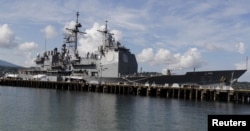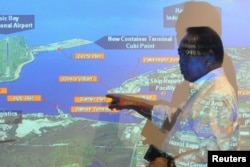More than two decades ago, the U.S. Navy closed it largest overseas base — Subic Bay in the Philippines. Filipinos resented the specter of American colonization at the base and had tired of servicemen causing trouble in hostess bars just off the base. But now the U.S. Navy is back and local people welcome the return of military personnel.
For more than a year now U.S. military personnel have returned to visit their former base at Subic Bay in the Philippines. But it’s not like the post-World War II years. Now the Armed Forces of the Philippines is in charge of the strategic port and wants American help in resisting China in contested waters off the west coast. Scarborough Shoal, where the two sides were locked in a standoff three years ago, is just 200 kilometers away.
“My opinion is, it’s OK the U.S. troops are here in the Philippines," said Lance Gboy, a 26-year-old driver by profession, explaining why he enthusiastically welcomes Americans back. "It’s a big help for us, especially the issue on Scarborough Shoal. Also most of my clients are American guys, so we don’t have a problem.”
China has sparred with the Philippines since 2012, when vessels from the two sides entered a two-month standoff at Scarborough Shoal off the Philippine west coast. A year later, Philippine President Benigno Aquino angered China by asking a U.N. tribunal to rule on the legal basis for Beijing’s claim to the most of 3.5 million-square-kilometer South China Sea.
A staunch military ally
Manila also claims the westernmost part of that sea, which is rich in fisheries — a mainstay of the Philippine economy — and may hold reserves of oil and natural gas. China’s military ranks third in the world, vastly ahead of the Philippines. So last year Manila signed an Enhanced Defense Cooperation Agreement with Washington, the archipelago’s former colonizer and still a staunch military ally.
That agreement lets the U.S. Navy use the deep-water bay to deliver material and personnel for annual joint military exercises. Six thousand U.S. personnel came to Subic for exercises in April. U.S. ships are also using Subic Bay as a resupply port during routine calls.
When the United States ran the 679-square-kilometer base, as many as 5,800 military personnel would be stationed there. The United States had colonized the Philippines from 1898 to 1946 after some three centuries of Spanish rule. Servicemen earned a poor reputation in the next-door city Olongapo over trouble with Philippine hostesses at as many as 60 bars.
New arrangement, with limitations
This time the Armed Forces of the Philippines are inviting American personnel back as they see fit, and that arrangement has eased fears of being colonized again. Olongapo business owner Stephen Lyon says the Philippine military’s control is a sweetener for turning public opinion.
“I think that’s what they’re doing, they’re saying it’s in control. The Philippines has always given the love to America. [But] there’s betrayal and issues in the past and worse,” said Lyon.
The Navy now restricts many of its personnel to a zone that excludes the bar district, apparently a rule put in place after a U.S. Marine private first class was charged with killing a local transgender man in an Olongapo hotel room. Military visitors today frequent a high-end mall with 200 stores, including numerous name-brand American chains.
People in Olongapo still expect returning U.S. personnel to stoke business for the 220,000 inhabitants. Mar Amil, a 45-year-old salesman, considered his bottom line as he peddled mobile phones along a busy highway frequented by foreign visitors.
“We like Americans to come back here in Subic," he said. "Because, you know the jobs here and the business, that’s why we like Americans to come back in the base. Everybody, 99 percent, they like Americans here. Don’t say something (like) Americans, you’re going to pull out, you (get) kicked out.”
U.S. personnel will go to Subic Bay again in April 2016 for joint exercises.












